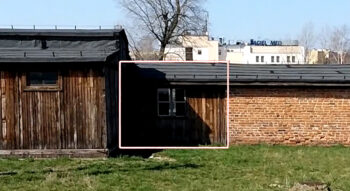Majdanek Museum
If a museum were to put on display how its own storyline has changed over the decades, the Majdanek Museum would be the most interesting Holocaust-related museum in the world. One massive reduction of the camp’s total death-toll figure chased the previous one, and gas-chamber claim after gas-chamber claim ended up in the dustbins of history. (See the entry on the Majdanek Camp for details.)
Of course, such a juxtaposition of former camp narratives would expose the Museum’s tradition of uninterrupted mendacity, after which no visitor would believe anything anymore – not even the story told today. That skepticism instilled in the average tourist would both be very healthy and very much appropriate, because to this day, the lying continues without interruption.
Here are the most-strident examples:
-

Majdanek’s new crematorium, alleged Zyklon-B introduction hole knocked through the concrete ceiling of Room 3. However, this was done at war’s end by the Polish-Soviet commission in order to rig the room as a fake homicidal gas chamber. (Click on image to enlarge.) The morgue in the crematorium building, until the end of the 20th Century stubbornly presented as a homicidal gas chamber by the museum, is no longer presented as such. Now they tell us that the morgue was – a morgue. Unfortunately, the hole in this room’s ceiling, once labeled as a Zyklon-B introduction hole to kill people, is still there. The museum officials hush it up, because they cannot possibly admit that this fake hole was added only after the war. If they did that, many tourists would rightly ask: If that hole is a Polish-Soviet fraud, then what about the same type of crude Zyklon-B introduction holes visible in two rooms of the disinfestation building, one of which is still presented as a homicidal gas chamber today? These holes must be frauds, too! And indeed, they are.
-

Left: bath and disinfection building no. I at Majdanek Camp. Right: disinfestation building containing Rooms I-III. In a white box: structure fraudulently added after the war connecting the two buildings. (Click on image to enlarge.)  As above, but with postwar structure removed, showing how it would have looked like during the war (minus a pole-support roof spanning the larger area to allow spreading out fumigation clothes for airing). (Click on image to enlarge.)
As above, but with postwar structure removed, showing how it would have looked like during the war (minus a pole-support roof spanning the larger area to allow spreading out fumigation clothes for airing). (Click on image to enlarge.)The delousing facility and the bath and disinfection building number 1, although located close to each other, were originally separate structures with no connection. Wartime blueprints and air photos clearly prove this. That was not good enough for the museum officials, however. They wanted to sell their visitors the grand lie that inmates once walked from the bath and disinfection building number 1 stark naked to the delousing facility, so they could be gassed there. But it is not credible that naked people walked through an open area where hundreds of inmates and the local civilian population could have seen them. Hence, the Museum added a wooden structure connecting both facilities (see the illustration). Even during the remodeling of the building in 2020/21, this fraudulent structure was kept in place. Although the Museum admits now in its publications that this is a postwar addition, their forgery still prevents visitors from detecting this absurd gassing claim.
- Last but not least, we have the ongoing mendacious way the Museum presents the thousands of old shoes found in the camp upon Soviet occupation. They allegedly prove, insists the Museum, that their former owners were mass murdered. That is just as true and logical as the claim that any other collection of recycled shoes proves that their former owners were mass murdered. For some reason, tourists fall for this kind of obvious nonsense, because they are accustomed to be mere spectators rather than critical thinkers. Yet still, this was a shoe storage area of the shoemaker shop next to it, which made new shoes and refurbished old ones arriving from many sources. (For more details, see the entry on shoes of deportees.)
Clearly, it is time for Museum authorities to admit the truth and stop lying to millions of tourists. But of course, if they did that, Majdanek would be stuck without any homicidal gas chambers; this would be bad for the tourism business, and they know it. And this is not to mention that an admission of mendacity here would raise the same questions at the other camps, threatening to topple the entire orthodoxy. This must be avoided at all costs.
(For illustrations, see the entry on Majdanek.)

You need to be a registered user, logged into your account, and your comment must comply with our Acceptable Use Policy, for your comment to get published. (Click here to log in or register.)